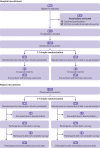Effect of chair placement on physicians' behavior and patients' satisfaction: randomized deception trial
- PMID: 38101923
- PMCID: PMC10726223
- DOI: 10.1136/bmj-2023-076309
Effect of chair placement on physicians' behavior and patients' satisfaction: randomized deception trial
Abstract
Objective: To evaluate the effect of chair placement on length of time physicians sit during a bedside consultation and patients' satisfaction.
Design: Single center, double blind, randomized controlled deception trial.
Setting: County hospital in Texas, USA.
Participants: 51 hospitalist physicians providing direct care services, and 125 observed encounters of patients who could answer four orientation questions correctly before study entry, April 2022 to February 2023.
Intervention: Each patient encounter was randomized to either chair placement (≤3 feet (0.9 m) of patient's bedside and facing the bed) or usual chair location (control).
Main outcome measures: The primary outcome was the binary decision of the physician to sit or not sit at any point during a patient encounter. Secondary outcomes included patient satisfaction, as assessed with the Tool to Assess Inpatient Satisfaction with Care from Hospitalists (TAISCH) and the Hospital Consumer Assessment of Healthcare Providers and Systems (HCAHPS) surveys, time in the room, and both physicians' and patients' perception of time in the room.
Results: 125 patient encounters were randomized (60 to chair placement and 65 to control). 38 of the 60 physicians in the chair placement group sat during the patient encounter compared with five of the 65 physicians in the control group (odds ratio 20.7, 95% confidence interval 7.2 to 59.4; P<0.001). The absolute risk difference between the intervention and control groups was 0.55 (95% confidence interval 0.42 to 0.69). Overall, 1.8 chairs needed to be placed for a physician to sit. Intervention was associated with 3.9% greater TAISCH scores (effect estimate 3.9, 95% confidence interval 0.9 to 7.0; P=0.01) and 5.1 greater odds of complete scores on HCAHPS (95% confidence interval 1.06 to 24.9, P=0.04). Chair placement was not associated with time spent in the room (10.6 minutes v control 10.6 minutes) nor perception of time in the room for physicians (9.4 minutes v 9.8 minutes) or patients (13.1 minutes v 13.5 minutes).
Conclusion: Chair placement is a simple, no cost, low tech intervention that increases a physician's likelihood of sitting during a bedside consultation and resulted in higher patients' scores for both satisfaction and communication.
Trial registration: ClinicalTrials.gov NCT05250778.
© Author(s) (or their employer(s)) 2019. Re-use permitted under CC BY-NC. No commercial re-use. See rights and permissions. Published by BMJ.
Conflict of interest statement
Competing interests: All authors have completed the ICMJE uniform disclosure form at www.icmje.org/disclosure-of-interest/ and declare: no support from any organization for the submitted work; no financial relationships with any organizations that might have an interest in the submitted work in the previous three years; no other relationships or activities that could appear to have influenced the submitted work.
Figures
Comment in
-
"Nudging" clinicians to communicate more effectively with patients in hospital.BMJ. 2023 Dec 15;383:2678. doi: 10.1136/bmj.p2678. BMJ. 2023. PMID: 38101921 No abstract available.
-
Der Doc sollte sich erst mal hinpflanzen.MMW Fortschr Med. 2024 Feb;166(2):35-36. doi: 10.1007/s15006-024-3617-9. MMW Fortschr Med. 2024. PMID: 38332281 Review. German. No abstract available.
References
-
- Yoong SL, Hall A, Stacey F, et al. Nudge strategies to improve healthcare providers’ implementation of evidence-based guidelines, policies and practices: a systematic review of trials included within Cochrane systematic reviews. Implement Sci 2020;15:50. 10.1186/s13012-020-01011-0 - DOI - PMC - PubMed
Publication types
MeSH terms
Associated data
LinkOut - more resources
Full Text Sources
Medical
Research Materials
Miscellaneous



